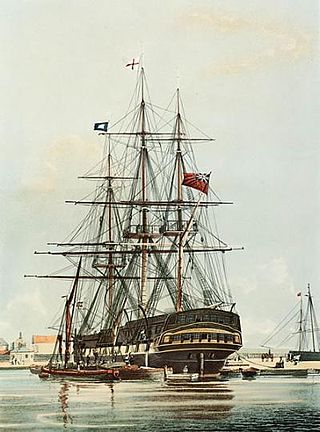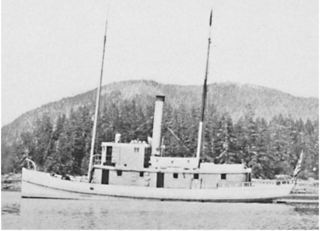
Star of India is an iron-hulled sailing ship, built in 1863 in Ramsey, Isle of Man as the full-rigged ship Euterpe. After a career sailing from Great Britain to India and New Zealand, she was renamed, re-rigged as a barque, and became a salmon hauler on the Alaska to California route. Retired in 1926, she was restored as a seaworthy museum ship in 1962–3 and home-ported at the Maritime Museum of San Diego in San Diego, California. She is the oldest ship still sailing regularly and also the oldest iron-hulled merchant ship still afloat. The ship is both a California Historical Landmark and United States National Historic Landmark.

East Indiaman was a general name for any sailing ship operating under charter or licence to any of the East India trading companies of the major European trading powers of the 17th through the 19th centuries. The term is used to refer to vessels belonging to the Austrian, Danish, Dutch, English, French, Portuguese or Swedish companies.

The Pacific Mail Steamship Company was founded April 18, 1848, as a joint stock company under the laws of the State of New York by a group of New York City merchants. Incorporators included William H. Aspinwall, Edwin Bartlett, Henry Chauncey, Mr. Alsop, G.G. Howland and S.S. Howland.

The Alaska Packers' Association (APA) was a San Francisco-based manufacturer of Alaska canned salmon founded in 1891 and sold in 1982. As the largest salmon packer in Alaska, the member canneries of APA were active in local affairs, and had considerable political influence. The Alaska Packers' Association is best known for operating the "Star Fleet," the last fleet of commercial sailing vessels on the West Coast of North America, as late as 1927.

Tradewind is a Dutch topsail schooner. She was built in the Netherlands in 1911 as a herring lugger named Sophie Theresia.
USS Wateree (ATA-174), the third ship named USS Wateree, was a Sotoyomo-class auxiliary fleet tug in the service of the United States Navy during World War II. She later served with the Military Sea Transportation Service and the Peruvian Navy as a diving support ship. In Peruvian naval service she was renamed BAP Unanue (ATA-136).
The Alphabet Fleet was a fleet of vessels owned and operated by the Reid Newfoundland Company as part of the provisioning of the 1898 Railway contract between the Dominion of Newfoundland and the Reid Newfoundland Company. The vessels were named after places in Scotland, the native homeland of Sir Robert Gillespie Reid, founder of the Reid Newfoundland Company.

Marlborough was an iron-built two-decked merchant sailing ship which disappeared in 1890. She was built by the firm of Robert Duncan and Co., Port Glasgow and launched in 1876 for her owner John Leslie, who later sold her to the Albion Line. Marlborough disappeared during a voyage in January 1890, and has not been seen or heard from in over a century. Searches and investigations have yielded nothing conclusive, and the ship's ultimate fate, and that of her crew, remains unknown.
Stephenson Clarke Shipping Limited, established in 1730 is Great Britain's oldest shipping company. The company specializes in short sea bulk cargo such as aggregates, alumina, grain, coal, fertilizers and steel.

RMS Empress of India was an ocean liner built in 1890-1891 by Naval Construction & Armaments Co, Barrow-in-Furness, England for Canadian Pacific Steamships. This ship would be the first of two CP vessels to be named Empress of India, and on 28 April 1891, she was the very first of many ships named Empress arriving at Vancouver harbor.

Ravenscrag is the name of several ships, some being sailing vessels and some steamships. One of the sailing vessels is historically significant for bringing to the Hawaiian Islands in 1879 Portuguese immigrants who subsequently introduced the ukulele to island culture.

The Hilma Hooker is a shipwreck in Bonaire in the Caribbean Netherlands. It is a popular wreck diving site.

The Carrier Dove was a 4-masted schooner built by the Hall Brothers in Port Blakely in 1890. She worked in the West coast lumber trade and in fishing.
The Star Line was a fleet of ships owned by timber merchants, Messrs. James P Corry and Co Ltd. of Belfast, Ireland. The shipping company was formed by Robert Corry in 1826 to import timber from Canada to Ireland. The company began to diversify in 1859 when trade with Calcutta began and the company relocated its offices from Belfast to London. This was followed by services to Australia and New Zealand in 1888, South America in 1903 and a joint emigrant service to Australia with Royden and Tyser Lines started in 1912. The company became a constituent part of the Commonwealth & Dominion Line in 1914, which was renamed Port Line in 1937.
SS Bury Hill was a cargo ship built in England during the First World War as Cardigan, later becoming Pensylvanie of Compagnie Générale Transatlantique (CGT). In 1934 she returned to the British register as Bury Hill but was wrecked on the coast of Senegal in 1936.

MV E Evangelia is a shipwrecked 7,355-gross register ton (GRT) refrigerated cargo ship at Costinești on the Black Sea coast of Romania. She was built in Northern Ireland in 1942 as the Empire ship Empire Strength, was operated by Blue Star Line from 1942 to 1961, was bought by Greek shipowners in 1965 and wrecked in 1968. The ship had four names in her career, having been renamed Saxon Star in 1946, Redbrook in 1961 and E Evangelia in 1965.

Methven Castle was a steam iron passenger cargo ship built in 1882–1883 by Barclay, Curle & Company of Glasgow for Donald Currie & Co. with intention of serving as cargo, passenger and mail carrier on their existing route from England to South Africa. The vessel was later sold to the North American Mail Steamship Co. of Tacoma to work on their Oriental trade routes and renamed Columbia. In 1899 the ship was chartered by the United States Army to transport troops and supplies to various overseas destinations. In 1900 the Army bought out the ship placing it in service as the United States Army Transport Rosecrans but sold it two years later to Matson Navigation Company. The vessel was then converted into an oil tanker to carry oil from the West Coast to Alaska and Hawaii. Subsequently she was sold in 1905 to Associated Oil Co. to carry oil from California to various ports along the Pacific Northwest and Hawaii. In January 1913 while on one of her regular trips, the ship was wrecked off the mouth of the Columbia River with the loss of almost her entire crew.
Emma was a merchant vessel launched at Calcutta in 1809 that in 1810 served as a government armed ship in the British invasion of Île de France. In 1811 she sailed to England where she was sold. She then became a transport and later a whaler. Between 1815 and 1853 she made 11 whaling voyages. She was then sold and became a merchantman on the England-Australia run. Between 1851 and 1853 she made one more whaling voyage to the South Seas fisheries. She then returned to the England-Australia trade. In 1857 her home port became Hull, and she became a Greenland whaler, though that role may have begun as early as 1855. She was converted in 1864 to a screw steamer but was lost in April while seal hunting.

The SS Scandinavian was a steamship built at Harland & Wolff in Belfast which entered service as an ocean liner in 1898. The ship changed names and owners several times; she was originally built for the Dominion Line and was known as New England, in 1903 she was transferred to the White Star Line and renamed Romanic. In 1912 she was sold to the Allan Line and renamed Scandinavian, the name which she retained for the rest of her career.

USFS Osprey was an American steamer that served as a fishery patrol vessel in the waters of the Territory of Alaska. She was in commission in the United States Bureau of Fisheries (BOF) from 1913 to 1921, and was the first vessel the BOF ever operated on fishery patrols in Alaska. Before the BOF purchased her, she was the commercial cannery tender Wigwam from 1895 to 1912. After her BOF career ended, she operated as a commercial motor tug with the name Foss No. 19 from 1922 to 1965 and with the name Kiowa from 1965 until she sank in 1978.














